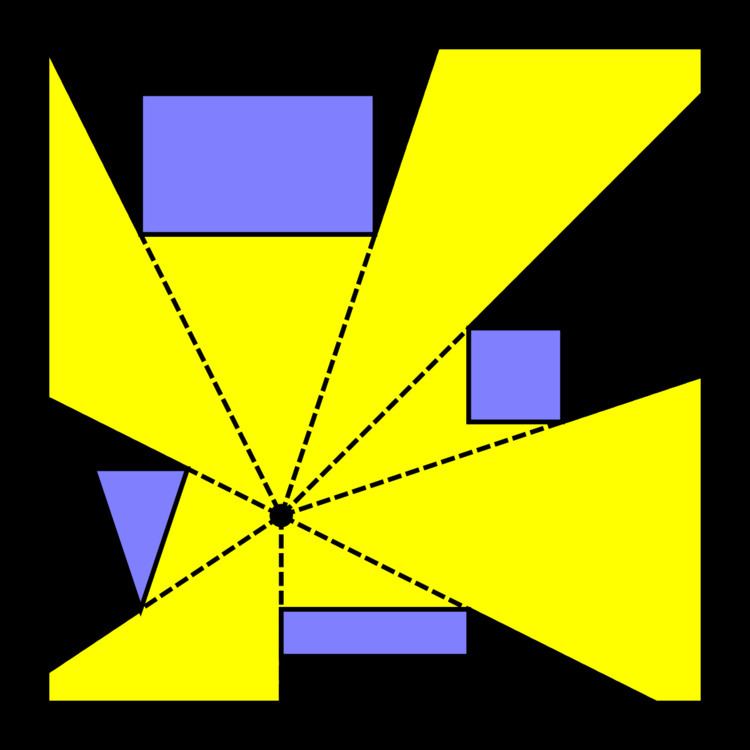 | ||
In computational geometry, the visibility polygon or visibility region for a point p in the plane among obstacles is the possibly unbounded polygonal region of all points of the plane visible from p. The visibility polygon can also be defined for visibility from a segment, or a polygon. Visibility polygons are useful in robotics, video games, and in determining positions to locate facilities, such as the best placement of security guards in an art gallery.
Contents
- Definitions
- Applications
- Algorithms for point visibility polygons
- Naive algorithms
- Uniform ray casting physical algorithm
- Ray casting to every vertex
- Optimal algorithms for a point in a simple polygon
- Optimal algorithms for a point in a polygon with holes
- Segments that do not intersect except at their endpoints
- Generally intersecting segments
- References
If the visibility polygon is bounded then it is a star-shaped polygon. A visibility polygon is bounded if all rays shooting from the point eventually terminate in some obstacle. This is the case, e.g., if the obstacles are the edges of a simple polygon and p is inside the polygon. In the latter case the visibility polygon may be found in linear time.
Definitions
Formally, we can define the planar visibility polygon problem as such. Let
Likewise, the segment visibility polygon or edge visibility polygon is the portion visible to any point along a line segment.
Applications
Visibility polygons are useful in robotics. For example, in robot localization, a robot using sensors such as a lidar will detect obstacles that it can see, which is similar to a visibility polygon.
They are also useful in video games, with numerous online tutorials explaining simple algorithms for implementing it.
Algorithms for point visibility polygons
Numerous algorithms have been proposed for computing the point visibility polygon. For different variants of the problem (e.g. different types of obstacles), algorithms vary in time complexity.
Naive algorithms
Naive algorithms are easy to understand and implement, but they are not optimal, since they can be much slower than other algorithms.
Uniform ray casting "physical" algorithm
In real life, a glowing point illuminates the region visible to it because it emits light in every direction. This can be simulated by shooting rays in many directions. Suppose that the point is
Now, if it were possible to try all the infinitely many angles, the result would be correct. Unfortunately, it is impossible to really try every single direction due to the limitations of computers. An approximation can be created by casting many, say, 50 rays spaced uniformly apart. However, this is not an exact solution, since small obstacles might be missed by two adjacent rays entirely. Furthermore, it is very slow, since one may have to shoot many rays to gain a roughly similar solution, and the output visibility polygon may have many more vertices in it than necessary.
Ray casting to every vertex
The previously described algorithm can be significantly improved in both speed and correctness by making the observation that it suffices to only shoot rays to every obstacle's vertices. This is because any bends or corners along the boundary of a visibility polygon must be due to some corner (i.e. a vertex) in an obstacle.
Algorithm naive_better_algorithm(The time complexity of this algorithm is
Optimal algorithms for a point in a simple polygon
Given a simple polygon
The latter algorithm will be briefly explained here. It simply walks around the boundary of the polygon
Optimal algorithms for a point in a polygon with holes
For a point in a polygon with
Segments that do not intersect except at their endpoints
For a point among a set of
Notice that any algorithm that computes a visibility polygon for a point among segments can be used to compute a visibility polygon for all other kinds of polygonal obstacles, since any polygon can be decomposed into segments.
Divide and conquer
A divide and conquer algorithm to compute the visibility polygon was proposed in 1987.
Angular sweep
An angular sweep, i.e. rotational plane sweep algorithm to compute the visibility polygon was proposed in 1985 and 1986. The idea is to first sort all the segment endpoints by polar angle, and then iterate over them in that order. During the iteration, the event line is maintained as a heap. An efficient implementation was published in 2014.
Generally intersecting segments
For a point among generally intersecting segments, the visibility polygon problem is reducible, in linear time, to the lower envelope problem. By the Davenport–Schinzel argument, the lower envelope in the worst case has
